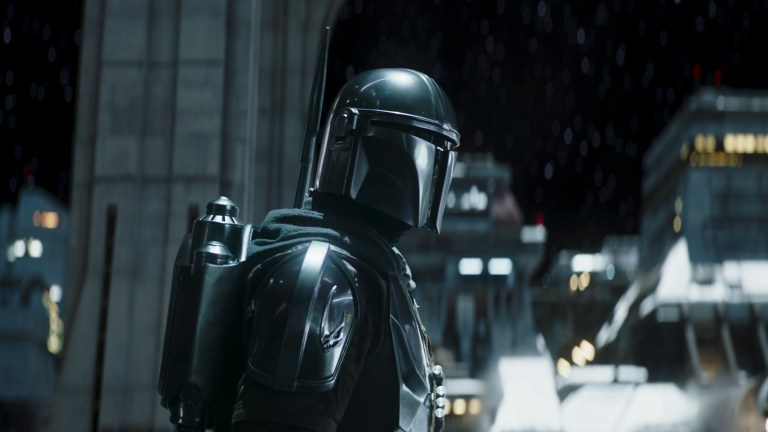Why The Mandalorian Is the Ultimate Star Wars Character
Din Djarin may stand on the shoulders of Star Wars heroes that came before, but he’s still the ultimate character from a galaxy, far, far away.

What do you get when you cross every single cool thing about Star Wars with itself? Since Return of the Jedi followed up the first two Star Wars films — A New Hope and The Empire Strikes Back — Lucasfilm has been obsessed with figuring out ways to remix and call back to what came before. The Original Trilogy closer brought back the Death Star. Revenge of the Sith gave us a Darth Vader origin. Rogue One re-introduced the Death Star and Vader for a new era. Solo is about, well, you know who it’s about, and in The Rise of Skywalker, somehow, Palpatine returned.
Along the way, various archetypes and motifs reoccur, over and over again, because like poetry it all rhymes, even though that’s not always true of real poetry. And just like not all poems rhyme, not all of this recycling in Star Wars works.
But it seems like Lucasfilm has finally found a different approach to recycling the core Star Wars tropes for a new generation: just dump them all into one character, specifically Din Djarin, The Mandalorian himself. With his Darksaber and flashy retro Naboo N-1 starfighter, Din has just become the ultimate Star Wars character because he embodies a kitchen sink approach to all the previous heroes.
You can start superficially. The brilliance of Star Wars has, for a long time, been exemplified by memorable characters wearing undeniably cool helmets or masks. From Luke’s X-wing fighter helmet to Darth Vader’s mask to the stormtroopers, from Leia’s bounty hunter disguise in Jedi to her son Kylo Ren — and of course, Boba Fett. A helmet, with a few exceptions, is key to the design of some of the most famous Star Wars characters. The character has a recognizable silhouette, instantly someone an adult dreams they could be and a child can draw with crayons.
Next up, you need a cool ship. Luke has his X-wing. Vader has his custom TIE. Han and Lando fight over the Millennium Falcon. Boba Fett flies his Firespray gunship. Even Cassian Andor and Jyn Erso zip across the galaxy in their own signature ride. Din Djarin has now had two cool ships, and by inheriting a style of starfighter once flown by Anakin Skywalker, he gets retro points, too. Sure, it was nostalgic to see Rey fly Luke’s X-wing in The Rise of Skywalker, but Din rocking an N-1 Starfighter comes as a genuinely surprising callback compared to a Sequel Trilogy that by Episode IX had revived much of the Original Trilogy iconography already.
Of course, Din now also has a bladed weapon akin to a lightsaber, and in The Book of Boba Fett, the literal weight of carrying the Darksaber is too much for him, a literal take on one of the Original Trilogy’s classic metaphors: the weight of carrying his father’s lightsaber on Luke. Both of their hero journeys take unexpected turns, too. In Mando and Boba Fett, Din isn’t ready to be a certain kind of warrior, and like Luke, rejects the training and ways of his ancient order of warriors to save someone he cares about. Like Luke, there are hints that Din has doubts about “the Way” of Mandalorian creed, his version of the Force.
Like Luke and Anakin, Din is a pseudo-orphan with a complicated relationship with both his actual family and his various found families, and who is thrust into a heroic adventure much bigger than he bargained for. But, like Han and Lando, Din is also a rogue with a heart of gold, wielding a healthy cynicism for the Force, the Jedi, the Republic, and pretty much every single other organization in the galaxy. In other words, he’s both on a naive hero’s journey like Luke or Rey and simultaneously on a redemption arc in the mold of Han and Lando.
While Din is a remix of various Star Wars character arcs and aesthetics, this exact mash-up is a far cry from the setup of the Original Trilogy. Han was a kind of counterpoint to Luke, and Leia a counterpoint to Han. Arguably, Han, Luke, and Leia tended to embody a small sliver of prescribed character traits throughout those films: Luke was good and naive, Han was the tough guy getting over himself, and Leia was the no-bullshit intellect holding it all together.
The thing is, in real life, people aren’t all one way or the other. Modern Star Wars has introduced some wiggle-room when it comes to archetypes (see: Luke in The Last Jedi) but, for the most part, hasn’t combined these tropes as brazenly before. That’s the true power of the Mandalorian. Although he may check off a lot of Star Wars boxes, these combined — and sometimes contradictory — features make him into something somewhat new to the faraway galaxy: a multi-layered, complicated, three-dimensional character.
